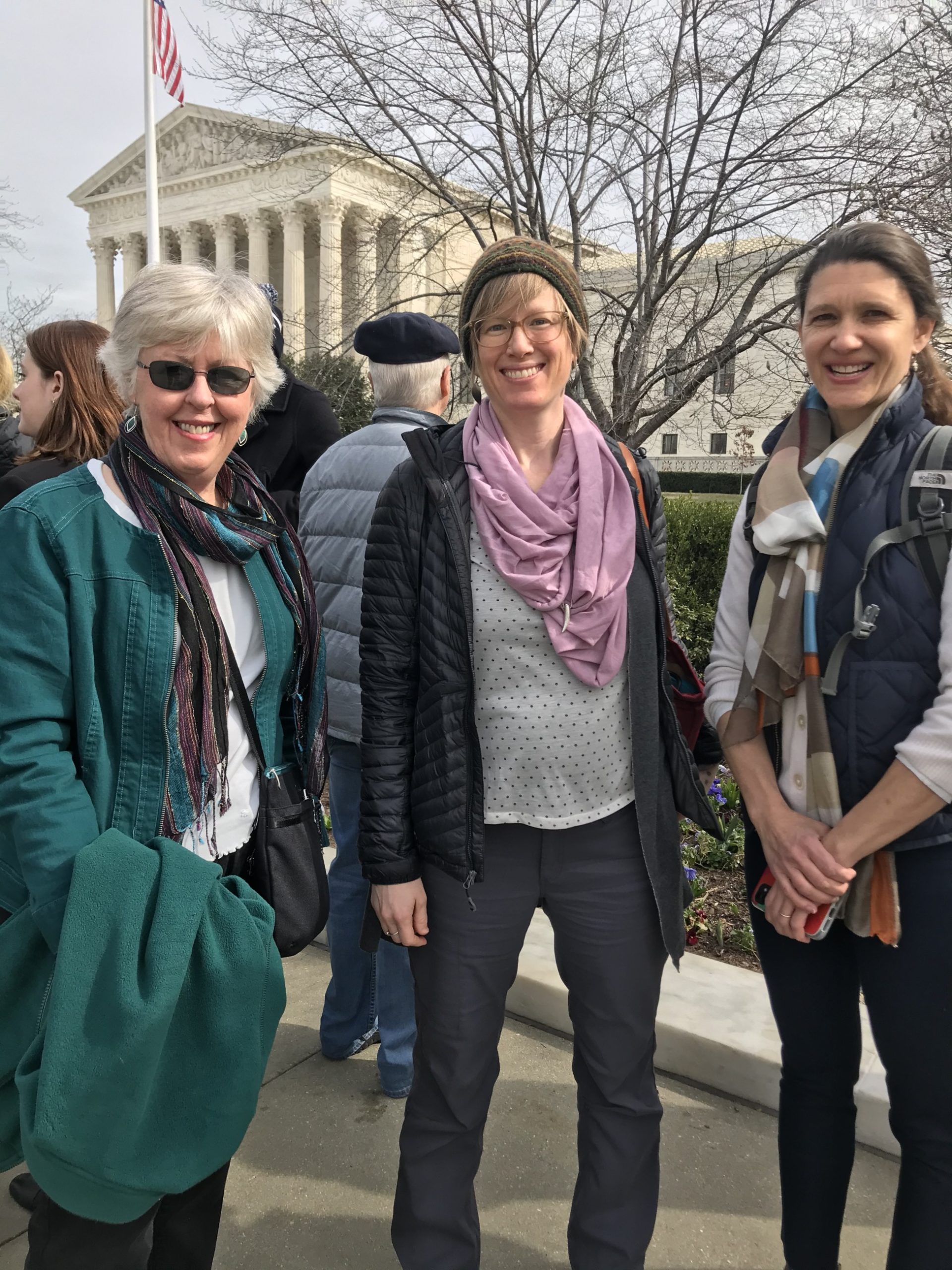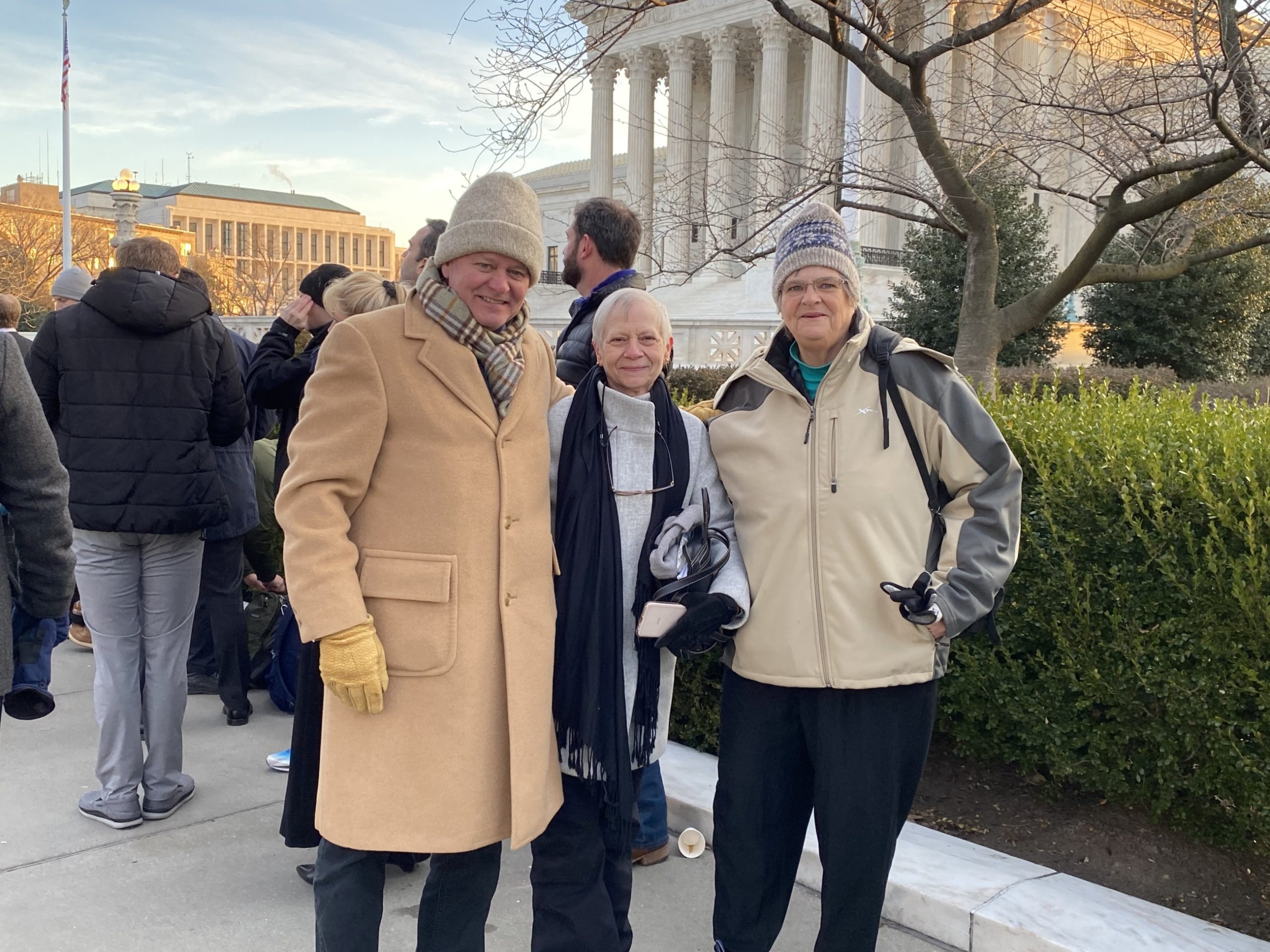When I got in the car on Sunday afternoon to make the trek to our nation’s capital to hear the Supreme Court arguments over the Forest Service’s authority to issue the Atlantic Coast Pipeline (ACP) a permit to cross the Appalachian Trail (AT), I was feeling like I was a part of something big. But I didn’t yet grasp why and how big.
Initially, my thoughts and conversation about the trip centered on the justices and the court itself and how this was seemingly a once-in-a-lifetime opportunity to see the final purveyors of justice and deciders-of-law hear a case that the Alliance is a respondent on, represented by the great Southern Environmental Law Center.
As the trip progressed and the cars filled up, the reality started to set in that it was going to be a long shot to actually get in to see the case argued. See, depending on the case, there are only about 50 seats open for the public to attend hearings. To get a seat, you must be in the first 50 people in line that morning at 7:30 when what became known as the ‘golden tickets’ are issued for however many seats are available.

Our plan was to drive up Sunday night, turn in early, and be up at about 4am to get in the line, and we were ready. We packed up camping gear, layers galore, and a good attitude in the face of hours outside on concrete in the dark in February. As we began to hear of others making the trip, the numbers started to add up – we’d brought waaay too many friends for us all to get in, never mind that it was very likely Dominion was also going to have people in line.
As this sank in, and after I got over the initial disappointment that I probably wouldn’t get to any of the famous Justices, I started to realize those people weren’t actually the heroes of the day.
Sitting around the dinner table, I heard Lynn Cameron of Friends of Shenandoah Mountain tell the story of how years ago, her husband Malcolm had noticed a tiny ad in the classifieds of the local Rockingham County paper about a hearing for a fracking well permit in Bergton. They mobilized some friends, reached out to Alliance legacy organizations working in the area, and attended the meeting, raising concerns over the implications for our water supply. If they hadn’t done that, the Rockingham County Board of Supervisors would have likely issued the permit that evening and we could have hydrofracking in our headwaters and maybe even pipelines like the ACP in the ground already.

Lately, Lynn has been the go-to tour guide to bring advocates to the AT overlooks that prove the Atlantic Coast Pipeline will indeed impact the viewshed and character of the trail, even though the actual route is a risky mile-long tunnel about 600 feet below the trail.
Later that night, after we heard that the line was already nearing the 50 people mark at about 9:30, we learned that two of our board members were in the 50 and ready to spend the entire night outside the courthouse.
Carolyn Long, a Shenandoah County resident and longtime advocate for responsible land use and economic development, had spent weeks reading up on the case nuance so she could follow the argument. And Bobby Whitescarver, from Swoope in Augusta County, a retired Natural Resources Conservation Service employee and now advocate for farming best management practice for water quality, has been in the fight against the ACP from the very beginning, with countless letters and calls to local representatives, state and federal agencies and lawmakers. He recently badgered the Department of Environmental Quality to release a condemning report that essentially admits that construction of the Atlantic Coast Pipeline will likely destroy the Deerfield Valley’s water supply (more on that soon).
Those two stood outside amongst ACP supporters and opponents for over nine hours (Bobby wrote about it in his blog here). At about 6am we got a call from Carolyn saying it was her plan the whole time to hold a spot for one of the Alliance’s staff and someone better go take her spot now. We were, and still are, in awe of Carolyn.

We decided to send Nancy Sorrells, who has been the boots on the ground in Augusta County since the ACP was proposed in 2014, tirelessly connecting with landowners and listening to the sorties of the unique real-life impacts of the destructive and unneeded pipeline to individuals along the route. And it wasn’t like Nancy was waiting around for the pipeline to be proposed so she’d have something to do – she stepped up in a way that is astounding and has been essentially a full-time activist, famous for her ‘death by a million cuts’ approach, constantly finding more and more wrong with Dominion’s plan. I could write many more words about Nancy’s work, but know, it was definitely her that deserved to be in that courtroom (you can read her story on her experience here).

Right before the case was scheduled to start at 10am, we headed down to the court to see how things were going. When we planned this trip, we thought the case was relatively low profile since the decision at hand was pretty narrow and immersed in decades old acts and laws. Boy were we wrong. There was still a line around the block filled with people hoping to get in to see just a few minutes of the arguments and even more people amassed to show their opposition by goose bump-raising chanting or gripping interpretive dance. These were all people I have never seen before, all fighting on our side from their corner of the world without us even knowing it.

Then there are these fine people – the lawyers and staff at Southern Environmental Law Center. They are the superheroes they look like in this photograph, but they are also so much more. What they’re not are aloof suits from afar buried in books and code only. Every single one of them has also strapped on backpacks and hiking boots and gone to see for themselves the destruction of the ACP. They’ve sat in the kitchen of affected landowners and know first-hand the intensely personal damage the ill-advised route causes to the people in the path.
Which brings me to the invisible-at-the-moment but most important heroes of all – the landowners and communities in the path of the pipeline. These people were going about their business, farming, working to improve their land and homes, and enjoying their rural and forested surroundings, when a private corporation notified them of a plan bulldoze a 42-inch pipeline across their land, beside their schools and through their waterways. These folks have been and continue to be the backbone of the resistance against the Atlantic Coast Pipeline and are the very reason there were way too many people in DC to get in to see the case. We were all there for them.
I can’t report first hand what happened in the courtroom, but there was a lot of thorough news coverage you can read here. The justices will spend the next few months contemplating the complicated legal issue in front of them and we expect to hear their verdict in late spring or early summer. The thing is, as big of a day as this was, this is one small part of a much bigger fight. We know the truth – the Atlantic Coast Pipeline will destroy public and private land and livelihood, will put wildlife and our water at risk, and will weaken our local economies that depend heavily on agriculture, recreation and tourism. And those truths are backed up by this and eight other challenged ACP permits that have halted construction at only 6% completion with no pipe in the ground in Virginia.
Obviously, this only scratches the surface of heroes that should be mentioned for their creative and tireless opposition. And, if you’re reading this, you too are the hero, and together we will continue to fight on the ground and in the courts because we’re right. This pipeline is dangerous and destructive and not needed AND most definitely not a done deal.


